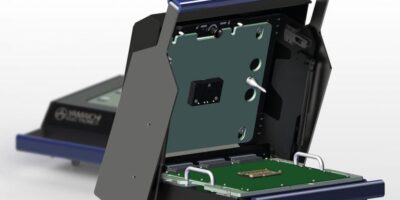Yamaichi maximises flexibility for assembly testing
Contacting standard low-signal-quality applications to high-performance embedded sub-assemblies is increasingly becoming a challenge, observes Yamaichi Electronics. In response it has introduced the test fixture Y-ETI which has a modular design.
Ever smaller embedded assemblies with increasing packing density must have 100 per cent secure functionality, continues Yamaichi. Such hardware cannot always be completely tested without external contacting, and high-precision contact units may be needed.
The Y-ETI’s modularity provides many options for contacting and testing electrical assemblies. The first variant has a base of approximately 566 x 463mm with a height of approximately 197mm. The available work surface, i.e. the maximum size of a device under test (DUT) for single assembly or multiple applications is therefore limited to approximately 270 x 270mm. A total of up to 1020 connections is available, which can process up to 12.5Gbits per second signals in the standard version. The necessary impedance and signal runtime adjustment is ensured on the test application board.
The main components of the test fixture are the basic box, the contact units and the extension box. The lever mechanism enables simple operation and horizontal or parallel contacting of the test sample, regardless of whether it has to be contacted only from one side or from the top and bottom in the sandwich method, says Yamaichi.
The connection to the respective test system environment is established through the extension box, which is docked to the back of the adapter through standard pylon interface blocks with six x 170 pins footprint. In contrast to most conventional test adapters, the extension box has the advantage that the Y-ETI is not bound to a test system.
By selecting the possible contact unit – either through a cassette or the test application board – the smallest possible test pitch is selected. As a rule, in case of assemblies with a larger test pitch and uncritical signals, the conventional cassette is used. The signal wiring is done using standard ICT pins and a wire wrap cable routing terminating on the back of the cassette on the standard 170-pin pylon interface blocks.
For applications with higher signal quality and fine pitch requirements, the test application board replaces the removable cassette. By using up to 0.2mm thin spring contacts, which are integrated in high-performance plastics, structures up to 0.25mm test pad spacing can be realised.
The Y-ETI is suitable for contacting a variety of electrical components, concludes Yamaichi, whether it is high-performance signal quality, narrow test pitch, single or double-sided contacting – the modular and very flexible, yet robust and easy-to-use structure provides the user with all options using cassette or test application board contacting.
Once set up, the Y-ETI is not bound to a test system configuration, but can be easily adapted to other environment interfaces with little effort, says the company.




